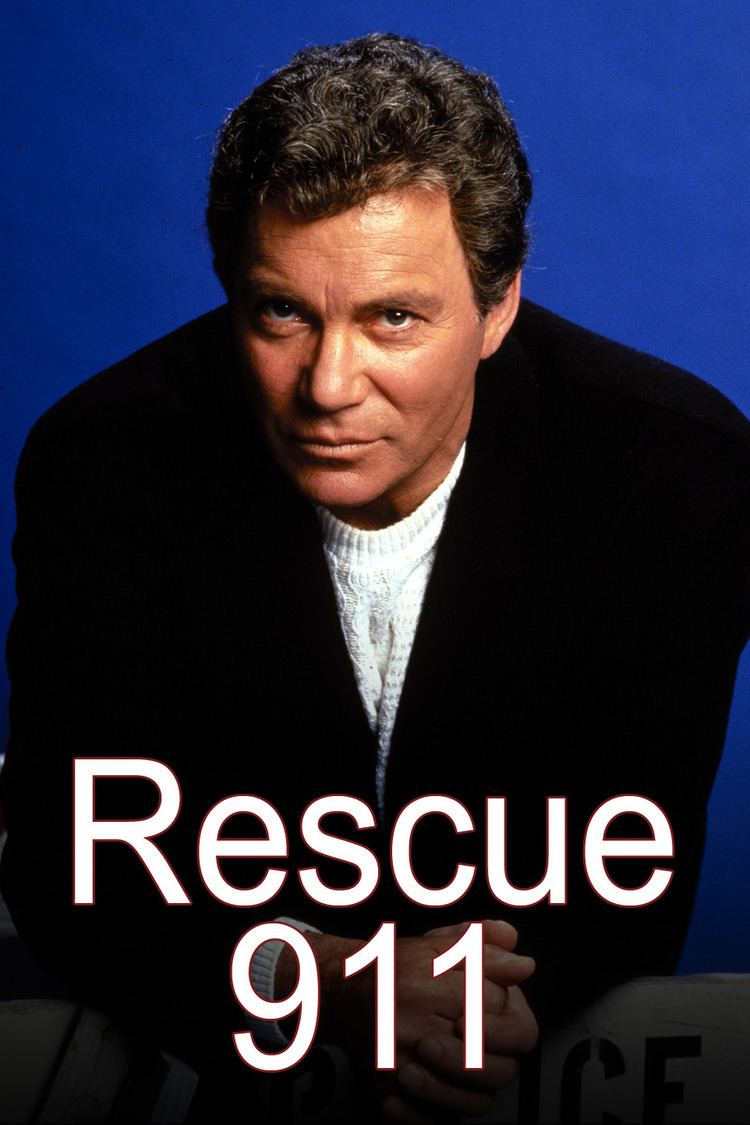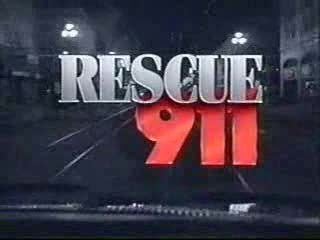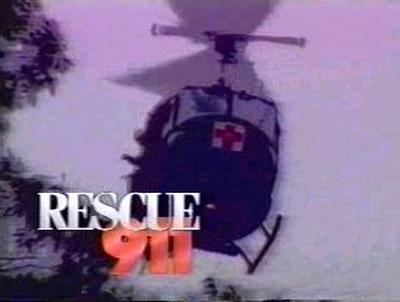7.8 /10 1 Votes
8.1/10 TV Theme music composer Scott Roewe First episode date 18 April 1989 | 7.5/10 IMDb Country of origin USA Theme song Rescue 911 Theme Song | |||||||||||||||||||||||||||||||||
 | ||||||||||||||||||||||||||||||||||
Written by Paula DeatsNancy Platt JacobyAaron KassJim MilioJean O'Neill Directed by Sheri GoldsteinMary HardwickNancy Platt JacobyJim MilioChris PechinRonnie WeinstockSegment directorsRon BrodyMark ColeMichael CollinsAllison GrodnerRobin GrothDan JacksonJim MilioSteve MuscarellaChris Pechin Similar Unsolved Mysteries, America's Most Wanted, Third Watch, America's Funniest Home Vid, It's a Miracle | ||||||||||||||||||||||||||||||||||
Rescue 911 family is in danger
Rescue 911 was an informational docudrama television series that premiered on CBS on April 18, 1989 and ended on August 27, 1996. The series was hosted by William Shatner and featured reenactments (and occasionally real footage) of emergency situations that often involved calls to 911.
Contents
- Rescue 911 family is in danger
- Rescue 911 episode 627 teen hides from intruders
- Broadcast history
- Additionalalternate timeslots
- Original format
- Syndicated format
- Presentation
- Situations
- Deaths
- Rescue 111
- Rescate 911
- Notruf
- Home video releases
- Books
- Toys and games
- Pinball machine
- References

Though never intended as a teaching tool, various viewers used the knowledge they obtained watching the show. Two specials, titled "100 Lives Saved" and "200 Lives Saved," were dedicated to these viewers who had written to CBS with their stories on how the knowledge they obtained watching the show allowed them to save the life of someone else. At least 350 lives have been saved as a result of what viewers learned from watching it. The show's popularity coincided with the widespread adoption of the 911 emergency system, replacing standalone police and fire numbers that would vary from municipality to municipality. The number is now universally understood in the United States and Canada to be the number dialed for emergency assistance nationwide.

At its height, the show was adapted in 45 countries (with their own 911 equivalent showcased).
Rescue 911 episode 627 teen hides from intruders
Broadcast history

Originally intended to be only a set of three TV specials, the show was picked up by CBS for the 1989 fall season after two specials aired on April 18 and May 9 of that year. It began airing as a regular series on September 5, 1989 and ran for 7 seasons, with the last new episode airing on August 27, 1996. The last episode to air on CBS (a repeat) aired on September 3, 1996.

Though it aired Tuesdays at 8:00 PM for most of its run, Rescue 911 occasionally aired on other nights either as an additional episode shown during that week, or a temporary rearrangement to make room for another program.
In 1993, The Family Channel (FAM) began airing reruns, but it was removed from the lineup when the Family Channel became the FOX Family Channel in August 1998.
In 1993, a reformatted version (see below) of the show was sold into off-network syndication. The syndicated version continued to air both in the U.S. and internationally long after the show's cancellation, but it has not aired in the U.S. since July 2005.
The following networks have aired the show in the syndicated format:
Additional/alternate timeslots
Season 2: Wednesday, 8 p.m.: April 1990 (in addition to Tuesday at 8 p.m.)
Season 3: Friday, 8 p.m.: January–February 1992 (in addition to Tuesday at 8 p.m.)
Season 7: Tuesday, 8 p.m.: September 1995, August–September 1996 (with the majority of the rest of the season airing on Thursdays at 9 P.M.)
Original format
When the show aired on CBS, episodes normally ran 60 minutes and featured four stories, although some episodes featured three or five stories. Three-story episodes were common during the second and third seasons, but became less common during the later seasons.
Because the show was paired with The CBS Tuesday Night Movie for most of its run, episodes with irregular running times were occasionally created to accommodate movies that didn't fit the regular two-hour time slot. Such episodes usually ran 30 minutes and contained two stories. Others included a 90-minute episode, a 50-minute episode, a 45-minute episode, and a 15-minute episode containing only one story.
From seasons one through five, an opening disclaimer was shown before each episode. Shatner's voice was heard saying:
"This program contains true stories of rescues. All of the 911 calls you will hear are real. Whenever possible, the actual people involved have helped us reconstruct the events as they happened."
In a few of the early episodes, the last sentence of the disclaimer said:
"Unless indicated, the actual people involved have helped reconstruct the events as they happened."
In seasons six and seven, three segments from the episode were previewed in place of the disclaimer, and a shortened version of the original introduction was shown. Reruns from earlier seasons that aired after September 1994 had their old introductions replaced by the new version of the introduction.
When reruns aired on FAM, episodes were edited for running time, censored for profanity and negative religious references, and graphic footage was sometimes cut out. FAM initially showed the opening disclaimer at the beginning of the episodes, but it was later replaced with a short teaser that previewed one or two segments from the episode. Season six episodes that aired on FAM had their introductions replaced with the original introduction, although the opening credits were not changed accordingly and were sometimes incorrect. Season seven episodes were never shown on FAM.
Syndicated format
The syndicated version of the show ran 30 minutes and typically included two stories, although a few episodes contained one long-running story. Some syndicated episodes featured stories that began on one episode and concluded on the next, which was never done in the show's original format. These syndicated episodes contained no new material; they consisted entirely of stories taken from episodes that aired in the original format. Stories featured on syndicated episodes were often edited for running time, omitting short scenes that were shown in the original broadcasts. Three-hundred syndicated episodes were produced, and they featured segments from the first six seasons of the show.
Presentation
Shatner would introduce episodes (and usually, all segments within them) from inside 911 dispatch centers or fire stations, or next to police cars and/or ambulances. He would end episodes from such locations as well. In addition, all segments included voiceover narration by Shatner, interview clips with the people involved and, in many cases, the actual recorded 911 call. Most segments were about 9 to 13 minutes in running time, although some ran shorter, particularly on five-segment episodes, and a few were longer in duration. Usually, the first segment of an episode included a commercial break shortly after the incident itself unfolded, and after the break Shatner would usually pick up again from the station the segment was introduced.
Unless otherwise specified, stories were presented in the form of re-enactments. Occasionally, recorded video footage of all or part of the event itself (usually amateur video or television news coverage) would be used. In these instances, Shatner would mention that a particular amount of footage was taped "as events unfolded" in the opening to a segment in which recorded footage was included. Many re-enactments required complex presentation, such as the recreation of house fires, automobile accidents, police chases, explosions, pregnant women in labor, and even natural disasters.
Some stories took place in the form of a documentary. In these stories, the show's camera crews would ride along with paramedics or police, or wait in hospitals and film whatever happened to unfold. These stories usually involved more than one event in a single segment at the same medical facility. One such story was the Charles Stuart murder case, which happened during a ride-along with Boston EMS.
In the show's early seasons, Shatner would close episodes with a statement advising viewers to learn the emergency numbers in their area and to post them by each phone, as not all areas had the 911 system back then. Later in its run, however, the closing statements focused on other lifesaving tips such as learning various first aid techniques, among other things.
Situations
Crimes, automobile accidents, medical emergencies, fires, choking/asphyxiation, and miscellaneous injuries were the most common situations presented on the show. Other situations commonly presented on it included technical rescues, near-drownings, childbirth, animal rescues, search and rescue situations, and aircraft-related emergencies. Occasionally, stories involving gas leaks, electrocutions, suicide attempts, scuba diving accidents, drug overdoses, train-related accidents, allergic reactions, and natural disasters were also presented.
Although the show mostly featured serious emergencies, it occasionally featured humorous stories of non life-threatening situations and false alarms. Examples included a burglar who got stuck upside-down when he tried to enter a house through the chimney, a young boy who got stuck in a laundry chute while playing hide-and-seek, a young boy whose tongue froze to the inside of a freezer while he attempted to get ice cream, a man who got a plaster mask stuck on his face, a dog that stepped on the 911 speed dial button after getting tangled in the phone cord (although it was in danger of being strangled), a woman who called 911 when she mistook her parents' new mannequin for an intruder, a boy who got his tongue stuck in a canteen, and a man who woke up to a break-in at his house, only to discover the burglar was a bobcat.
A few segments featured on the show had previously gained national news coverage. These incidents included the New Year's Eve 1986 fire at Puerto Rico's DuPont Plaza Hotel, the 1987 Amtrak train wreck in Maryland, two segments on Hurricane Hugo, the June 1990 Ohio tornado, the Stuart murder case, the Salt Lake City Public Library hostage incident, and the Oklahoma City bombing.
Deaths
Although the majority of stories featured ended with all lives being saved, there were some exceptions in which one or more victims died. Such occurrences became exceedingly rare later in Rescue 911's run, and usually occurred in documentary segments or in those reenacting multiple casualty incidents in which other victims survived.
Rescue 111
In New Zealand, TV2 began screening the first season of Rescue 911 in 1991 and subsequent seasons following this. At the start of each episode, the network would display a reminder to viewers that the emergency number in New Zealand is 111. In 1992, with the permission of CBS, the show was renamed to Rescue 111 in New Zealand. This was done following reports of New Zealanders calling 911 in emergencies instead of 111. The show's starting was shortened with a Rescue 111 title replacing the Rescue 911 title. Its format remained the same, however, with Shatner still addressing the show as Rescue 911 along with all stories mentioning calling 911. When the final series screened in New Zealand in 1996, the show was simply called Rescue.
Rescate 911
Rescate 911 featured episodes from the U.S. version of Rescue 911 dubbed over in Spanish. It aired in Ecuador from 1994 to 2000 on RTS and currently airs on Oromar Televisión.
Notruf
German network RTL started its own version with a mix of cases from Germany and the US in 1992. The show ran for over 14 years, with the last episode broadcast on August 27, 2006.
Home video releases
In Rescue 911's early seasons on CBS, ads were shown after the end credits of every episode that gave an 800 number viewers could call to order a copy of that night's episode. This ad was dropped in later seasons.
On May 27, 1997, "Rescue 911: World's Greatest Rescues" was released on VHS. This video featured five stories of rescue attempts from around the world; segments were taken from both the U.S. and international versions of the show. The segments on the video were edited for running time, and the original narration on all segments (including those originally narrated by Shatner) were dubbed over by an uncredited narrator. The two stories taken from the U.S. version were about a New Zealand girl pinned beneath a flaming gasoline tanker (season three, episode 25) and the infamous documentary of the Stuart murder case in Boston, Massachusetts (season one, episode 20). The other three stories, taken from international versions of the show were about a Belgian family trapped in a car hanging precariously from a high overpass, a Russian hostage crisis in which a terrorist held two women captive, and an Austrian skier who fell into an underground glacier river.
Books
Several books were written that recounted stories featured on Rescue 911:
Toys and games
Pinball machine
In May 1994, Premier Technologies, trade-name Gottlieb, released a Rescue 911 pinball machine. It featured a helicopter that magnetically captured the ball as well as a red revolving light on the backbox. In March 2016, it was released in The Pinball Arcade for PC, Android mobile devices and iOS.
